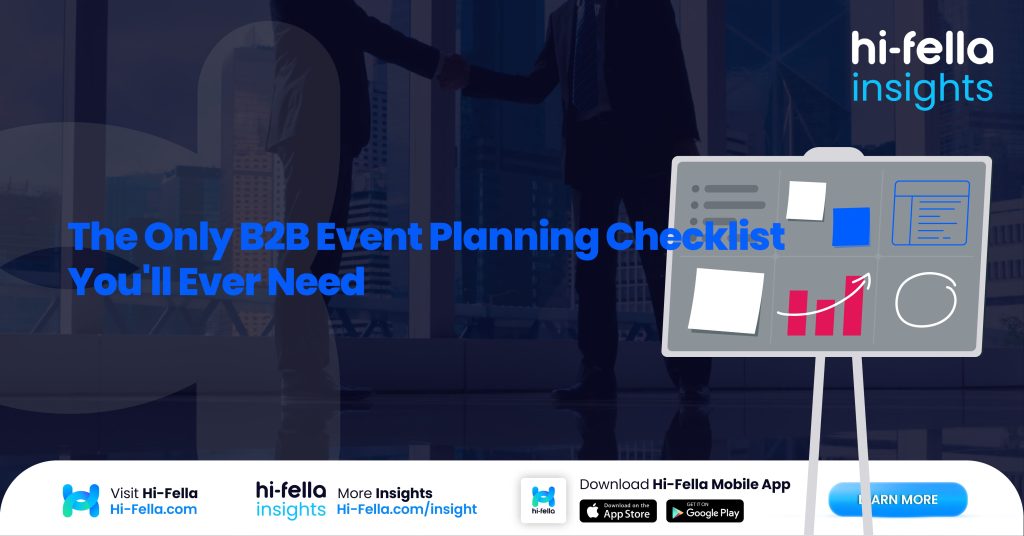Planning a successful B2B event requires careful thought, organization, and the right tools to ensure that every component aligns with your overall business objectives. Whether you’re hosting a large conference, a networking event, or a product launch, the planning process involves a multitude of steps that can easily become overwhelming if not managed well. However, with the right approach, a B2B event can be a powerful driver of brand awareness, lead generation, and business growth.
In this comprehensive guide, we’ll provide you with the ultimate B2B event planning checklist. From setting clear objectives to creating the perfect event experience, managing logistics, and attracting the right audience, we’ll help you navigate every step of the process to ensure your event delivers maximum impact and value.
Table of Contents
Defining Your B2B Event Goals: Setting Clear Objectives for Maximum Impact
Before diving into the logistics and details of your event, it’s crucial to define your objectives. Having clear, measurable goals will not only help guide your planning efforts but will also allow you to assess the success of the event afterward. Whether your aim is to increase brand awareness, generate leads, build relationships, or establish thought leadership, understanding your purpose is vital to making your event effective and impactful.
Setting Clear Event Objectives
The first step in any B2B event is understanding why you are hosting it. This can range from generating qualified leads to increasing brand recognition or networking with key stakeholders. Once you identify your goals, make sure they align with your company’s larger business objectives. Here are some common event goals:
- Brand Awareness: If your goal is to increase your brand’s visibility, your event should be designed to highlight your products or services in front of as many potential clients as possible.
- Lead Generation: If you’re looking to generate leads, focus on activities like Q&A sessions, product demonstrations, or interactive workshops that facilitate engagement and capture attendee information.
- Networking: If relationship-building is key, ensure that your event offers plenty of opportunities for guests to connect with one another, such as through designated networking sessions or one-on-one meeting opportunities.
- Thought Leadership: Positioning your business as an expert in your industry can help build trust and credibility. This can be achieved by organizing panels, hosting expert speakers, or leading discussions on trending topics.
Measuring Event Success
To measure the effectiveness of your event, determine specific key performance indicators (KPIs) beforehand. These might include metrics like the number of leads generated, the level of engagement during presentations, or post-event feedback. You can also use surveys to collect valuable insights from attendees on what worked well and what could be improved.
By clearly outlining these goals and aligning them with your broader business strategy, you’ll have a solid foundation for planning and executing a successful B2B event.
Crafting the Perfect Event Experience: Venue, Technology, and Content
Now that you’ve set your goals, it’s time to focus on creating a memorable and engaging experience for your attendees. A great B2B event experience requires attention to detail in three key areas: the venue, the technology, and the content.
Choosing the Right Venue
The venue plays a critical role in the overall success of your event. Whether it’s a physical, virtual, or hybrid event, your venue should align with the goals of your event. Here’s how to make sure you choose the right venue:
- Physical Event: If you’re hosting an in-person event, the venue should be convenient for your target audience to attend. Consider factors such as location, accessibility, parking, and capacity. Ensure the venue has the necessary facilities, such as audio-visual equipment, breakout rooms, and space for networking activities.
- Virtual Event: For virtual events, choose a platform that allows you to host your event seamlessly. Look for platforms with interactive features like live polling, Q&A sessions, and breakout rooms to encourage audience engagement.
- Hybrid Event: For a hybrid event, you’ll need to ensure the physical venue supports live streaming and that you select a virtual platform that integrates well with the in-person experience.
Selecting the Right Technology Tools
The technology you use for your event is just as important as the venue itself. For virtual and hybrid events, technology plays an even more crucial role in delivering a smooth, interactive experience. Here are some tools to consider:
- Event Registration and Ticketing: Use software that streamlines event registration, tracks attendance, and manages ticket sales. Platforms like Eventbrite or Cvent can help manage the entire process.
- Virtual Event Platforms: For virtual and hybrid events, choose a platform like Hopin, Zoom, or Airmeet to facilitate smooth interactions, networking, and live streaming.
- Event Apps: Event apps like Whova or Bizzabo can help attendees navigate the event, view schedules, and network with other participants.
- Interactive Tools: Engage your audience with live polls, Q&A sessions, and surveys through tools like Slido or Mentimeter to boost interaction.
Crafting Valuable Content
Content is the backbone of your event experience. Whether it’s keynote speeches, panel discussions, or workshops, the content should be relevant, insightful, and engaging. Here’s how to ensure your content is aligned with your goals:
- Tailor Content to Your Audience: Ensure that your content speaks to the specific pain points and interests of your audience. Create content that educates, inspires, and helps attendees solve problems.
- Incorporate Interactive Elements: Include interactive features like live polling, breakout discussions, or hands-on workshops to keep your attendees engaged and make the content more actionable.
- Invite Thought Leaders: Include expert speakers and industry leaders to provide credibility and valuable insights, positioning your event as a go-to source for knowledge.
By aligning your content with your event’s objectives and ensuring it resonates with your target audience, you’ll create an experience that is both memorable and valuable.
Building the Right Audience: How to Attract and Engage Targeted B2B Attendees
Attracting the right audience to your B2B event is crucial for its success. Without the right attendees, even the best-organized event won’t have the desired impact. The key to attracting and engaging the right audience is effective market segmentation and personalized marketing.
Market Segmentation and Attendee Personas
Before launching your marketing campaign, segment your audience based on their needs, interests, and level of decision-making. Create attendee personas that represent different segments of your target audience. These might include:
- Decision-Makers: Executives, managers, and directors who influence or make purchasing decisions.
- Influencers: Professionals who recommend products but don’t make the final decision.
- End-Users: Those who will directly use the product or service offered.
By segmenting your audience, you can tailor your marketing efforts to meet the specific needs of each group and increase the likelihood of attracting the right people.
Marketing Campaigns for B2B Events
Utilize a mix of marketing channels to promote your event, including:
- Email Marketing: Send personalized invitations and event updates to your segmented list. Use automated tools to track engagement and send reminders.
- Social Media: Leverage LinkedIn, Twitter, and other platforms to engage with potential attendees. Use sponsored ads and organic posts to promote the event and highlight key speakers or topics.
- Partnerships: Collaborate with industry associations, influencers, or media outlets to co-promote the event and increase its reach.
Managing Logistics and Budget: Tips for Streamlined Execution
Effective logistics management is key to ensuring your event runs smoothly. This involves everything from vendor relationships to managing the budget and preventing common logistical issues.
Managing Vendor Relationships
Start by selecting trusted vendors for catering, AV equipment, event signage, and more. Establish clear contracts and expectations to ensure everything is delivered on time and within budget.
Setting a Realistic Budget
When setting your budget, prioritize spending on elements that directly impact your event’s goals. Invest in the venue, technology, and content creation first, and allocate funds for marketing, staffing, and other logistics as needed. Use tools like Trello or Asana to manage tasks and ensure everything is on track.
Preventing Common Logistical Issues
Common event planning issues include venue delays, AV malfunctions, and shipping errors. To mitigate these risks, ensure you have a contingency plan in place. Double-check all contracts and technical requirements in advance, and always have backup equipment or a support team ready.
Join Hi-Fella Today!
Planning and executing a successful B2B event requires careful attention to detail, clear objectives, and effective tools. Hi-Fella offers a platform that can help you connect with the right suppliers, partners, and clients to ensure your event is a success. By joining Hi-Fella, you can access a global network that provides valuable insights, resources, and collaboration opportunities to help you host memorable, high-impact B2B events.
Whether you’re organizing a small networking event or a large-scale industry conference, Hi-Fella provides the tools you need to amplify your reach, create valuable connections, and drive long-term business success.








